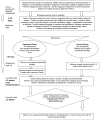Design features of the Diabetes and Periodontal Therapy Trial (DPTT): a multicenter randomized single-masked clinical trial testing the effect of nonsurgical periodontal therapy on glycosylated hemoglobin (HbA1c) levels in subjects with type 2 diabetes and chronic periodontitis
- PMID: 24080100
- PMCID: PMC3885354
- DOI: 10.1016/j.cct.2013.09.010
Design features of the Diabetes and Periodontal Therapy Trial (DPTT): a multicenter randomized single-masked clinical trial testing the effect of nonsurgical periodontal therapy on glycosylated hemoglobin (HbA1c) levels in subjects with type 2 diabetes and chronic periodontitis
Abstract
Background: Evidence suggests that periodontitis is associated with prevalent and incident type 2 diabetes mellitus (T2DM), raising the question of whether periodontitis treatment may improve glycemic control in patients with T2DM. Meta-analyses of mostly small clinical trials suggest that periodontitis treatment results in a modest reduction in glycosylated hemoglobin (Hb) A1c.
Purpose: The purpose of the Diabetes and Periodontal Therapy Trial (DPTT) was to determine if periodontal treatment reduces HbA1c in patients with T2DM and periodontitis.
Methods: DPTT was a phase-III, single-masked, multi-center, randomized trial with a planned enrollment of 600 participants. Participants were randomly assigned to receive periodontal treatment immediately (Treatment Group) or after 6 months (Control Group). HbA1c values and clinical periodontal measures were determined at baseline and 3 and 6 months following randomization. Medication usage and dosing were assessed at each visit. Periodontal treatment consisted of scaling and root planing for a minimum of two 90-minute sessions, plus the use of an antibacterial mouth rinse for at least 32 days afterwards. The primary outcome was change in HbA1c from baseline to 6 months and the trial was powered to detect a between-group difference of 0.6%. Secondary outcomes included changes in periodontal clinical measures, fasting plasma glucose, the Homeostasis Model Assessment (HOMA2) and the need for rescue diabetes or periodontal therapy.
Conclusion: Dental and medical researchers collaborated to recruit, treat and monitor participants with two chronic diseases to determine if treatment of one condition affects the status of the other.
Trial registration: ClinicalTrials.gov NCT00997178.
Keywords: Diabetes mellitus; Glycosylated hemoglobin; HbA1c; Periodontal disease; Periodontitis; Type 2.
© 2013. Published by Elsevier Inc. All rights reserved.
Figures
References
Publication types
MeSH terms
Substances
Associated data
Grants and funding
LinkOut - more resources
Full Text Sources
Other Literature Sources
Medical


